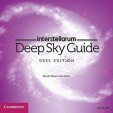 interstellarum: Deep Sky Guide, Desk Edition By
interstellarum: Deep Sky Guide, Desk Edition By
- Ronald Stoyan &
- Uwe Glahn
The interstellarum Deep Sky Guide is meant to be the amateur observer’s one-stop celestial cartography resource. Containing images of more than 2,300 deep-sky objects (including stellar clusters, planetary nebulae, galaxies and quasars), along with short descriptions and instructions on how to best observe these objects, this compendium offers a wealth of information for anyone looking to observe the night sky. The book also offers finding charts for the majority of these objects, based on Palomar Observatory Sky Survey II plates and sketches by the authors.
 Einstein’s Monsters: The Life and Times of Black Holes By
Einstein’s Monsters: The Life and Times of Black Holes By
- Chris Impey
The advent of the gravitational wave era also introduced a new and independent piece of evidence for the existence of black holes. Chris Impey, in this book, discusses all there is to know about ‘Einstein’s monsters’, as he calls them. He presents the history of how they came to be — first as theoretical constructs and then as observational necessities, the astrophysics of how they form and evolve, where they live and how we observe them, including a full chapter on gravitational waves. The book gives an awe-inspiring account of the complexity and beauty of black holes that were there before our Galaxy formed and will probably be there after everything else has been shredded apart by the forces of an ever-expanding Universe.
 Ronald Reagan and the Space Frontier By
Ronald Reagan and the Space Frontier By
- John M. Logsdon
Walking in the steps of John F. Kennedy, who entered the USA in the space race to the Moon, and Richard Nixon, who drove forward the space shuttle program, Ronald Reagan set the foundation for the International Space Station. John M. Logsdon brings together information gathered from declassified documents of the era and interviews with members of Reagan’s administration to create a picture of USA space policy between 1981 and 1989. The author particularly showcases how the president and his policymakers had to deal with an ever more complex situation in space, including the Challenger space shuttle disaster in 1986, cooperation with an ambivalent Soviet Union and a push for space commercialization.
Author information
Authors and Affiliations
Corresponding author
Rights and permissions
About this article
Cite this article
Karouzos, M. On our bookshelf. Nat Astron 3, 13 (2019). https://doi.org/10.1038/s41550-018-0672-0
Published:
Issue Date:
DOI: https://doi.org/10.1038/s41550-018-0672-0



